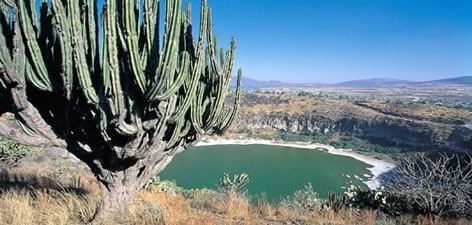
Introduction | Family Programs | Local Tours | Excursions | Horseback Riding | Adventure | Sports | Spa
| This stretch of the Sierra Madres offers numerous sites that make leaving the crown jewel of San Miguel worthwhile. Here are the most delightful detours: |
| Guanajuato, The capital of the state of Guanajuato, this city of 120,000 has been named a UNESCO World Heritage Zone. Built in a deep crevasse, Guanajuato has a distinctly European feel with its many parks and outdoor cafes. The principal park, called the Jardin Union, is surrounded by gorgeous colonial buildings including the magnificent Teatro Juarez. Subterranean tunnels keep much car traffic out of the center of town. The many historical and cultural sites worth visiting include Diego Rivera’s boyhood home, an iconography museum of Don Quixote images (the city is the host to a three-week Cervantes festival in October) and the eerie Museum of the Mummies. |
| Pozos, Less than 45 minutes from San Miguel is the rugged town of Pozos, officially known as Pozos de Mineral. For several centuries, Pozos produced an assortment of minerals, from silver to mercury, and the town, now mostly in ruins, has the mines to show for it. Recently, newcomers have begun renovating crumbled buildings, turning them into hotels, restaurants and art galleries. Pozos has been called by some the “Next San Miguel” and described as looking like San Miguel did 40 years ago. Spend the day walking the cobblestoned streets, exploring the mines and eating lunch in a shady courtyard of one of four delightful restaurants. |
| Dolores Hidalgo, This is where Father Miguel Hidalgo delivered the famous “El Grito de Dolores,” the battle cry that begun the Mexican War for Independence in 1810. The main square is beautifully preserved, with the rose-colored Parroquia de Nuestra Senora de los Dolores — the church where Hidalgo issued el grito on the north side. The town, 30 minutes north of San Miguel, is known for its homemade ice cream and talavera tile. |
| Atotonilco, The main reason to stop in this pueblo 15 minutes north of San Miguel is to see the fascinating Sanctuary of Atotonilco, an important Mexican shrine and a United Nation’s World Heritage site. The walls and ceiling of the church and the six chapels, built in 1740, are adorned with intricate frescoes and folk murals. |
| Querétaro, The capital of the state of Querétaro is one of the most surprising colonial cities in the area. It has a very well preserved historical center with several of magnificent old mansions and some of the country’s finest architecture. It is a lively and undiscovered city that is prettiest at night with its many plazas filled with bars and restaurants. It is said to be one of Mexico’s cleanest cities and 1996 it was inscribed as a World Heritage Site because of its unique street plan and colonial monuments. Main sites of interests are the Church of San Francisco; the former monastery Museo Regional de Querétaro and the former market square Plaza de la Constitución. Don’t forget to shop for Mexican opals that are mined nearby. |
| To the north of San Miguel is a seam of thermal springs that you can enjoy at one of the several balnearios along the road toward Dolores Hidalgo. A local favorite is La Gruta (tel. 185-2099), a sophisticated spa with several pools, one inside a man-made cave, lovely grounds and a restaurant. Another balneario worth visiting is El Escondido (185-2022), where three interconnecting indoor pools get progressively hotter. The best spot for children is Balneario Xote (614-5889), with its many slides and water-spewing mushrooms. |
| The most beautiful and plentiful of the many visitors that come to Central Mexico in the winter is the glorious Monarch butterfly. In the mountains of the state of Michoacan, three to four hours south of San Miguel, are two butterfly sanctuaries open to the public. Hundreds of millions of monarchs spend the winter clinging together in clumps that look like large growths of Spanish moss dripping from fir-tree branches. They come to this remote and high (10,000 feet) spot from all over the U.S. and Canada to hibernate and, as the weather warms, to mate. The mining town of Angangeuo is the closest staging point to both preserves. The best times for viewing the monarchs is February and early March. |
|
Subscribe to our Newsletter
|
| $50 Amazon Voucher up for grabs every month! Sign-up now »
|
Search Destination Traveler
|
|
|
Featured Destinations
|